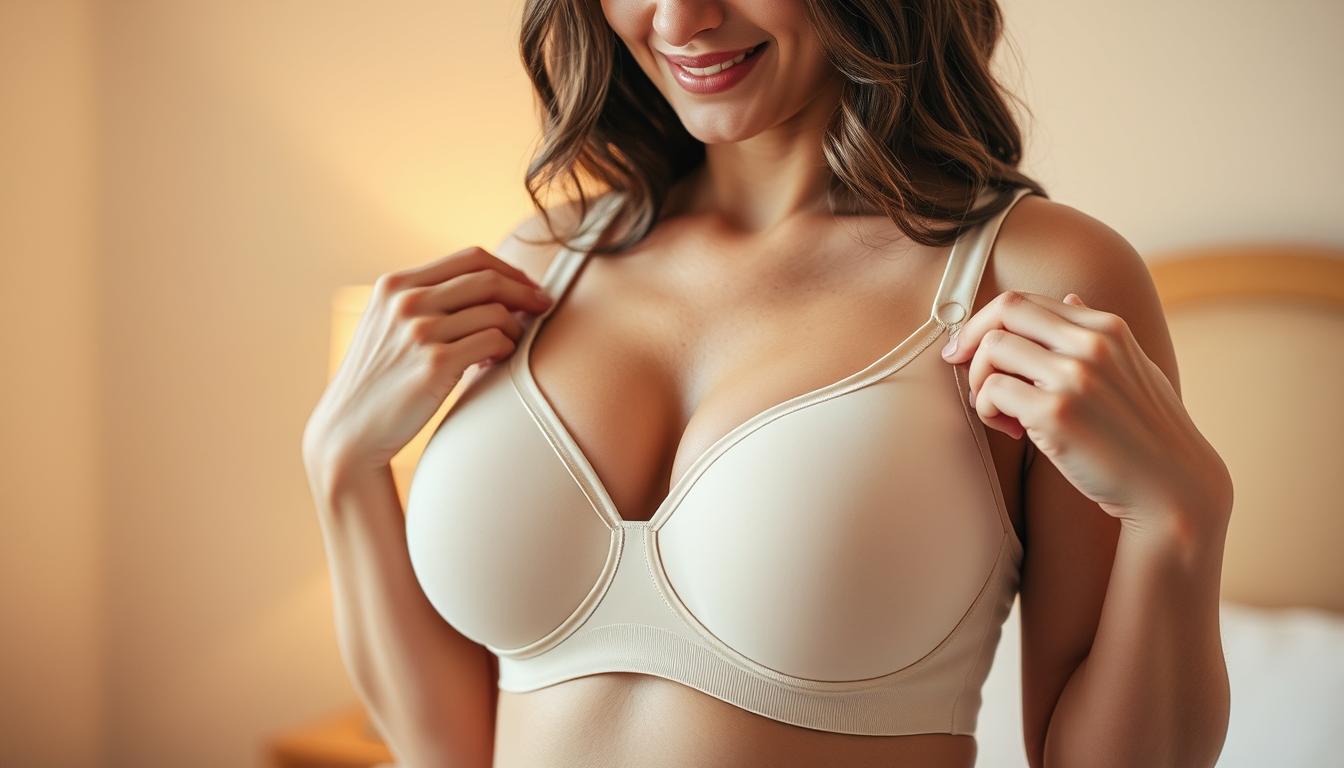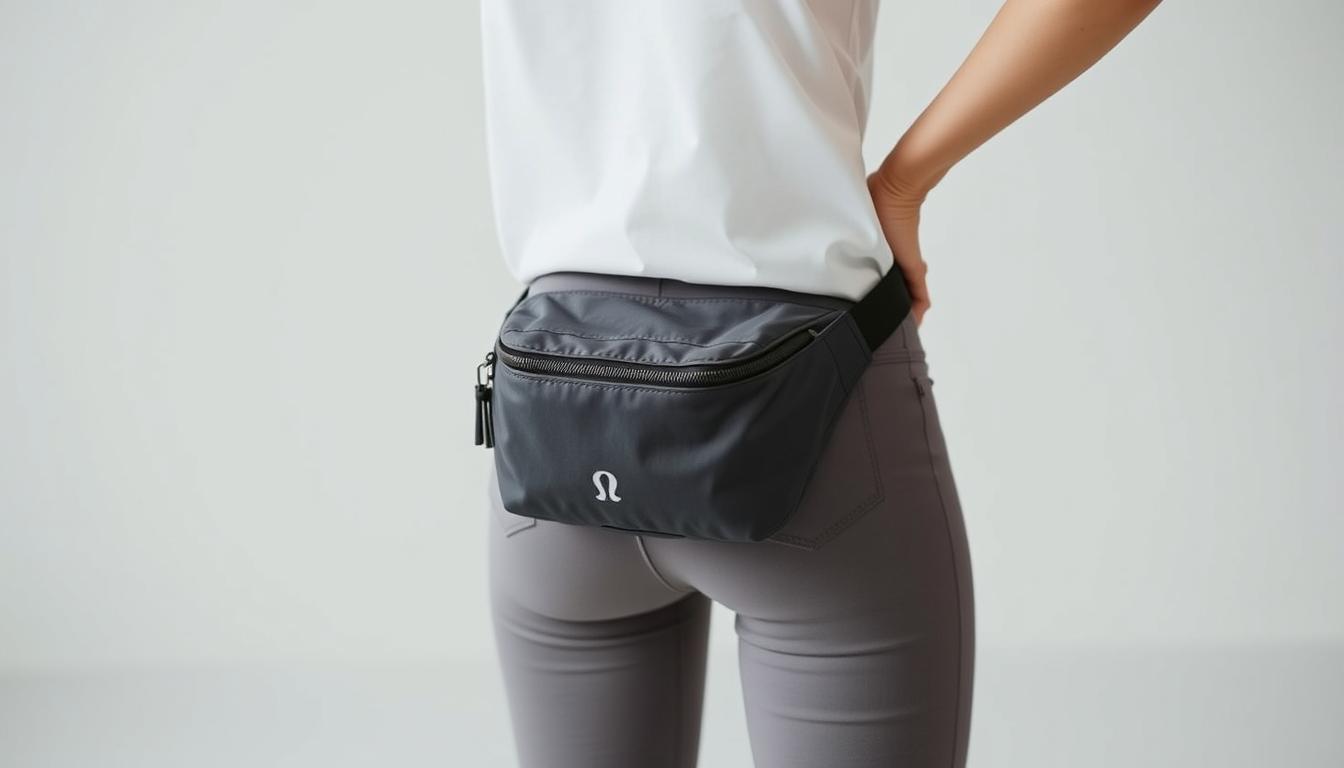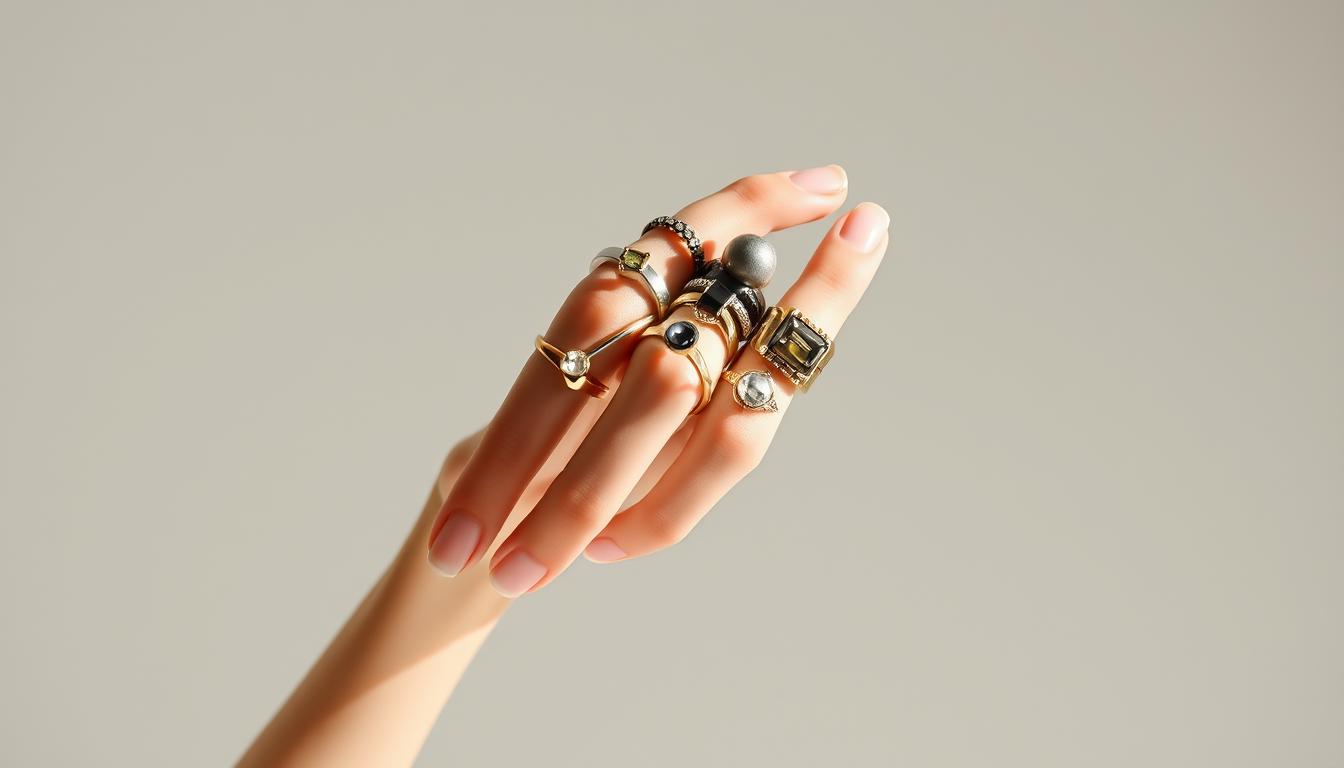After a lumpectomy, you need to focus on your healing. Choosing the right bra and knowing how long to wear it is key. Your recovery depends on the support you get, which is very important.
Dealing with post-surgical breast care can be tough. Many patients are unsure about when to wear a bra after a lumpectomy. The time you need to wear a bra varies based on your healing, the surgery, and doctor’s advice.
Your recovery is unique, and you need care that fits you. Doctors usually give you specific advice on bra wear. Knowing the basics can make you feel more prepared for your healing. The right support is not just about feeling good physically. It’s also about helping you recover well and keeping your spirits up.
Key Takeaways
- Consult your surgeon for personalized bra wearing instructions
- Expect initial wearing periods to focus on gentle, supportive compression
- Soft, wireless bras are typically recommended during early recovery
- Individual healing times can vary significantly
- Comfort and proper fit are essential during post-surgical recovery
Understanding Lumpectomy and Post-Operative Care
Going through a lumpectomy can seem scary, but knowing what to expect makes it easier. Our guide covers the key points about this important surgery.
What is a Lumpectomy Procedure?
A lumpectomy is a surgery that takes out a tumor or cancer while keeping most of the breast. Doctors remove the bad tissue carefully, trying not to harm the breast too much. It’s different from a mastectomy because it only takes out the bad part.
- Typically performed as an outpatient procedure
- Requires local or general anesthesia
- Focuses on preserving breast appearance and function
Immediate Post-Surgery Requirements
Good care after surgery is key for a smooth recovery. Patients need to follow certain bra guidelines to help heal and feel less pain. A comfy, supportive bra is a must in the early days.
- Wear a soft, surgical support bra immediately after procedure
- Avoid underwire bras during initial healing
- Prioritize comfort and gentle compression
Initial Recovery Phase
The first weeks after surgery are very important. Patients usually need to wear a special bra all the time, even at night. This helps support and protect the healing area.
Healing times can vary, but most people start to feel better in 2-4 weeks. Always talk to your doctor for advice on your recovery. They can give you tips that fit your situation.
How Long to Wear a Bra After Lumpectomy
Figuring out how long to wear a bra after a lumpectomy can be tricky. Everyone’s recovery is different. But, we’ve got some key tips to help you understand the bra-wearing time frame.
Usually, you’ll need to wear a supportive surgical bra all the time for the first 1-2 weeks after surgery. This helps reduce swelling, offers gentle pressure, and keeps the surgical area safe.
- Right after surgery: Wear the surgical bra day and night
- First 2 weeks: Keep wearing a bra for support
- 2-6 weeks: Start wearing softer, more comfy bras
How long you’ll need to wear a bra can change based on a few things:
- How fast you heal
- The type of surgery you had
- Your medical history
- What your doctor says
It’s best to talk to your doctor for advice that fits your needs. They can give you the best guidance based on your recovery and surgery.
Choosing the Right Post-Surgery Bra
Finding the right bra after breast surgery can be tough. It’s key to pick one that’s comfy and supportive during your recovery. The right bra can really help your healing and comfort.

When picking a bra after surgery, look for certain features. These are important for your recovery and well-being.
Recommended Bra Features
- Front closure design for easy wearing
- Soft, breathable fabric that minimizes irritation
- Wide, adjustable straps for optimal support
- Wireless construction to prevent pressure on surgical sites
- Seamless interior to reduce friction
Materials and Comfort Considerations
The right materials can really affect your comfort during recovery. Look for bras made from:
- Cotton blends for breathability
- Moisture-wicking fabrics
- Soft, stretchy materials that accommodate slight swelling
Size and Fit Guidelines
Finding the perfect fit for a bra after surgery is important. We suggest:
- Getting professionally measured after surgery
- Choosing a slightly looser fit to accommodate healing
- Ensuring no tight elastic bands near surgical areas
- Selecting bras with multiple hook-and-eye closures for adjustability
Remember, your comfort is the most important thing during recovery. A well-chosen bra can give you the support and gentle care your body needs while healing.
Post-Operative Bra Wearing Schedule

Figuring out your bra schedule after surgery can be tough. Our tips for lumpectomy bra care will guide you through the recovery process. The first weeks are key for healing and support.
Wearing your post-operative bra correctly is vital for healing and comfort. Here’s a simple guide for wearing your surgical support bra:
- First 24-48 hours: Continuous bra wear is recommended
- Week 1-2: Wear surgical bra day and night
- Week 3-4: Daytime bra wearing with occasional breaks
- After 4 weeks: Transition to comfortable support bras
Important tips for your recovery include:
- Choose soft, wire-free bras with gentle compression
- Ensure proper fit to avoid irritation
- Listen to your body and adjust as needed
- Consult your healthcare provider for personalized guidance
Comfort is essential during your recovery. Your surgical bra should be supportive but gentle. It should help reduce swelling and protect your healing tissues. Always put your comfort first while following medical advice.
Signs of Proper Bra Fit During Recovery
Finding the right bra after breast surgery can be tough. We know how important it is to find a good fit during your lumpectomy recovery. Your comfort and healing are our main concerns when picking the perfect bra.

Choosing the right bra is more than just comfort. It’s about supporting your recovery journey. The best post-surgery bra should feel like a gentle, protective hug that helps your healing.
Comfort Indicators to Watch For
- No pressure on surgical sites
- Soft, breathable fabric against sensitive skin
- Minimal seam contact with healing areas
- Adjustable straps for personalized support
Warning Signs of Poor Fit
Your body will tell you if a bra isn’t right during recovery. Watch out for these signs:
- Persistent discomfort or pain
- Pinching or binding around surgical areas
- Fabric rubbing against healing wounds
- Restricted movement or breathing
When to Adjust Your Bra
Recovery changes every day. Your bra needs might change too. Listen to your body and be ready to make changes. A well-fitted bra can make a big difference in your comfort and healing.
Check your bra when:
• You notice increased swelling
• Your wound healing changes
• Your breast tissue shifts
• Your healthcare provider suggests a check-up
Remember, finding the right bra is a personal journey. What works for one person might not work for another. Always talk to your medical team for personalized bra guidelines.
Managing Discomfort and Pain While Wearing a Bra

Recovering from a lumpectomy means paying close attention to comfort, like choosing the right bra. Our tips are here to help you feel better and more confident during this time.
Managing pain after a lumpectomy can be tough. Here are some ways to make it easier:
- Choose soft, wireless bras with gentle compression
- Use cotton-based materials that breathe and reduce irritation
- Opt for front-closure designs to minimize movement
- Consider bras with soft, padded straps to reduce pressure
Comfort is key when you’re healing. Soft, seamless bras offer the support you need without adding pain. Look for bras with:
- Wide, cushioned bands
- Adjustable straps
- Breathable fabric
- Minimal seams and embellishments
If pain persists, talk to your healthcare provider. They can give you advice that fits your needs. Remember, everyone heals differently, and listening to your body is important.
Finding the right bra can greatly improve your comfort and recovery. Take your time to find the perfect fit. And don’t hesitate to make changes as you heal.
Transitioning to Regular Bras After Surgery
Going back to your regular bra collection after a lumpectomy is a big step in your healing. Knowing when to switch to regular bras is key for healing and feeling good.

Everyone’s recovery is different, but most can start thinking about regular bras in 4-6 weeks. The advice usually is to slowly move to regular bras, focusing on your healing and comfort.
Knowing When You’re Ready
Look for these signs that you might be ready for regular bras:
- Surgical site has fully healed
- No significant pain or discomfort
- Medical professional has cleared you for normal activities
- Swelling has significantly reduced
Selecting Your First Regular Bra
When picking your first bra after surgery, remember these tips:
- Start with soft, wireless designs
- Choose breathable, gentle materials
- Make sure it’s comfortable and doesn’t feel too tight
- Think about getting a professional bra fitting for the best support
Always talk to your doctor for advice on when to switch to regular bras. Every recovery is unique, and their guidance helps you make the best choices for your healing.
Physical Activity and Bra Requirements During Recovery
Staying active after breast surgery is important, but you need to follow certain guidelines. Your body should move gently, and you must have the right support for healing and comfort.
After a lumpectomy, start with slow and careful physical activities. The right bra can greatly improve your recovery and comfort.
- Week 1-2: Focus on light walking and gentle stretching
- Week 3-4: Introduce mild upper body movements
- Week 5-6: Consult your doctor about increasing activity levels
When choosing a bra for physical activities during recovery, look for these features:
- Wide, soft straps to minimize pressure
- Wireless design for maximum comfort
- Breathable, moisture-wicking fabric
- Adjustable closure for changing body needs
Compression-style sports bras are good for gentle support. They should not restrict the surgical area. Choose bras made for post-surgical recovery for the best comfort and healing.
Keep in mind, everyone recovers differently. Always listen to your body and follow your healthcare provider’s advice. This will help you during your lumpectomy recovery journey.
Common Complications and How to Avoid Them
Recovering from a lumpectomy needs careful attention to avoid complications. We know managing your healing can be tough. But with the right bra care tips, you can reduce risks and support your recovery.
It’s important to know about possible complications during your recovery. Our expert advice will help you stay ahead and informed about your healing journey.
Infection Prevention Strategies
Keeping infections away requires a few steps. Here are key strategies to keep your surgical site clean:
- Maintain strict hygiene around your surgical area
- Choose breathable, soft bras that minimize moisture
- Clean your wound as recommended by your healthcare provider
- Avoid tight bras that can trap bacteria
Wound Care Considerations
Proper wound care is key for a smooth recovery. Your bra selection plays a critical role in supporting healing. Here are important wound care tips:
- Select bras with gentle, non-irritating fabric
- Ensure proper fit to prevent unnecessary friction
- Monitor your surgical site for any unusual changes
- Change bras frequently to maintain cleanliness
By following these bra care tips, you’ll create a great healing environment. This will help reduce the risk of complications during your recovery.
Tips for Sleeping and Nighttime Bra Wear
Recovering from a lumpectomy means paying close attention to your bra wear at night. The right bra is key for healing and comfort while you sleep. We’ll share important tips for a restful and supportive night.
Choosing the right sleep bra is vital for your recovery. Nighttime support is critical when figuring out how long to wear a bra after a lumpectomy. Look for these features in your nighttime bra:
- Soft, breathable fabric
- Gentle compression
- No underwire
- Adjustable straps
- Front closure for easy wearing
Comfort is key during your recovery. Wear a soft, supportive sleep bra for the first few weeks. This helps reduce movement and supports the surgical area.
| Recovery Stage | Nighttime Bra Recommendation | Duration |
|---|---|---|
| Initial Recovery | Soft surgical bra | 2-4 weeks |
| Intermediate Recovery | Comfortable sleep bra | 4-6 weeks |
| Late Recovery | Light support bra | 6-8 weeks |
Pro tip: Listen to your body. If you feel discomfort or pain, change your bra or talk to your healthcare provider. Everyone recovers differently, so what works for one might not work for another.
Also, your sleeping position can affect your comfort. Try sleeping on your back with a supportive pillow to reduce pressure on the surgical area. Avoid stomach or side sleeping until your healthcare provider says it’s okay.
When to Contact Your Healthcare Provider
Following your lumpectomy recovery bra guidelines is key. Your body will send signals that you need to pay attention to. Sometimes, you might need to talk to your doctor for help.
Your bra after breast surgery is important for healing. But, some signs mean you should see a doctor right away. Here are the signs that mean it’s time to call your healthcare provider.
Red Flags During Recovery
- Persistent fever above 101°F
- Increasing redness or warmth around the surgical site
- Unusual discharge or bleeding through your surgical bra
- Severe pain unmanaged by prescribed medications
- Significant swelling that doesn’t subside
Emergency Situations
Some symptoms need quick medical help. Here’s a quick guide to help you know when to act fast:
| Symptom | Action Required |
|---|---|
| Chest pain | Call emergency services immediately |
| Difficulty breathing | Seek urgent medical care |
| Signs of infection | Contact healthcare provider within 24 hours |
Remember, your health and recovery are the most important. If something doesn’t feel right, don’t hesitate to reach out to your medical team.
Long-term Bra Wearing Considerations
Your journey with bra recommendations after a lumpectomy doesn’t stop after you recover. As time goes on, how you wear a bra will change. You’ll need to pay close attention and find new ways to adapt.
Building a good bra wardrobe is key. Think about these important points for long-term comfort and support:
- Get professional bra fittings every 6-12 months
- Choose high-quality, soft bras
- Watch for changes in your breasts and adjust your bra style
- Find comfort without losing support
Breast tissue can keep changing after surgery. So, it’s important to be flexible with your bra choices. Look for bras with:
- Adjustable straps
- Soft, breathable materials
- Wire-free designs for more comfort
- Gentle compression features
Talking to your healthcare provider is also vital. They can give you advice on bra wearing that fits your recovery and needs.
Your comfort and confidence are the most important things. The right bra can really help with your physical and emotional health after surgery.
Conclusion
Going through the lumpectomy recovery period for bras can be tough. But, with the right steps, you’ll find comfort and confidence. Knowing how long to wear a bra after lumpectomy is key for healing and feeling good.
Every person’s journey is different, needing patience and listening to your body. We’ve looked at important tips for wearing bras after surgery. This includes picking the right supportive clothes and knowing when to make changes.
The main thing is to follow your doctor’s advice and listen to your body. Wearing the right bra during recovery is not just about healing. It’s also about keeping your sense of self and emotional health.
Your recovery is a journey of change. By following the tips we’ve shared, you’ll create a supportive healing space. Remember, healing takes time, and there’s no rush. Focus on your comfort, trust your medical team, and be kind to yourself.
As you move forward, your story becomes a symbol of strength and resilience. The right bra wear after surgery can greatly impact your recovery. It helps you feel supported both physically and emotionally.





